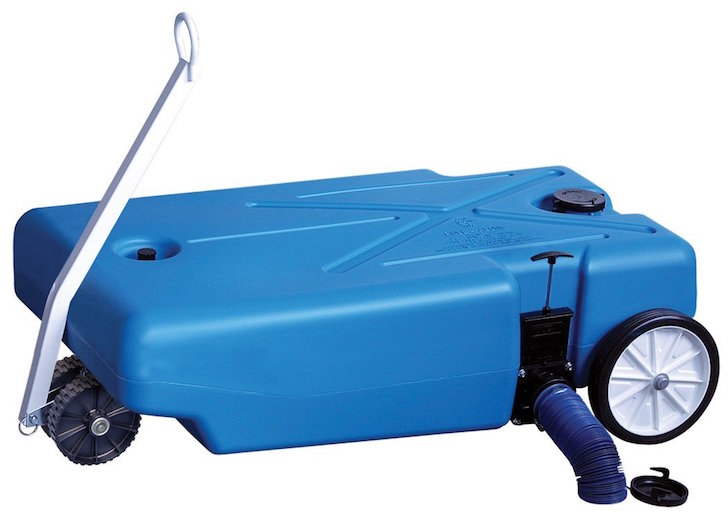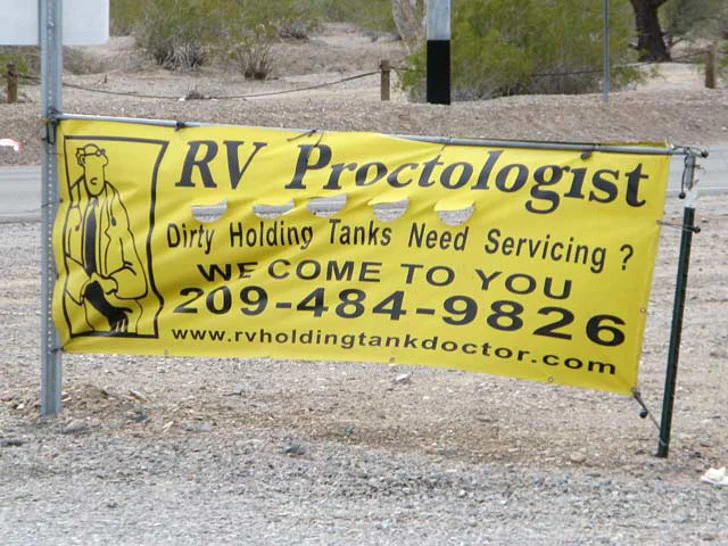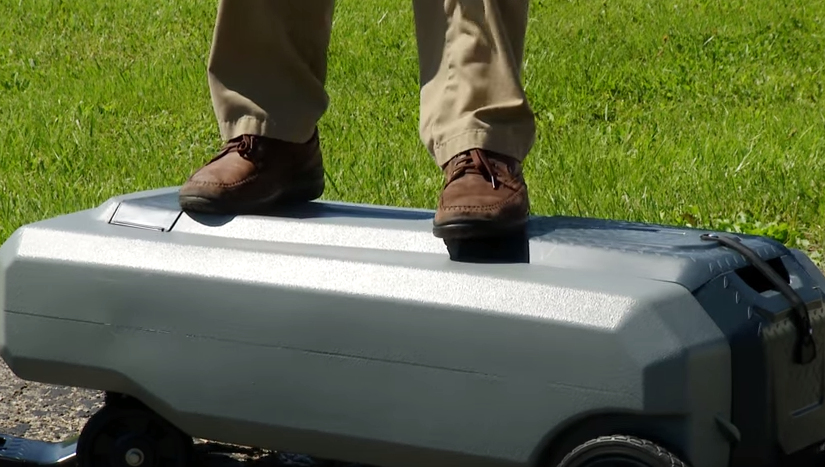A blue boy is another name for a portable waste water container. These tanks come in a variety of sizes, from around five gallons to upwards of 30 gallons or more.
While they’re sometimes made of blue plastic – hence the ‘blue boy’ name – they’re used to transport ‘greywater’. Gray water (or graywater) is the name for waste water after it has passed down your sink or shower – but not from the toilet.
If the water comes from the toilet, it’s called ‘black water’. Some RV parks prohibit blue boys from carrying black water, but yes you can transport poop (blackwater) if need be.
A typical large ‘blue boy’ waste tank of 42 gallon size.

Blue boy portable waste water tanks usually have a couple of wheels on one end, and an easy-to-grip handle on the other.
They’re designed to transport waste water from your RV’s holding tanks to a nearby dump station.
The tanks have a drain connection, fill connector, usually come with fill hoses, and some have a hitch adapter for pulling with a vehicle.
Can You RV Without A Blue Boy?
Some RVers have questioned the utility of a portable waste water container, figuring that if their RV has a 200 gallon capacity waste water tank, what’s the use of a 30 gallon blue boy tote?
Most RVers prefer to just drive over and dump their tanks at the dump site. Others, however, don’t like the idea of having to pick up camp just to dump their tanks.
Packing up a trailer or motorhome that’s been properly leveled and stabilized can be quite the inconvenience.
The consensus seems to be that you don’t need a blue boy tank, but some RVers find them helpful, especially those who like to camp in parks without a sewer connection at each site.
How to Use A Blue Boy Waste Tank
Using a blue boy portable waste container is a fairly simple process. First, you fill up the container with waste water from your RV’s holding tanks. The tanks take the standard hoses with bayonet fittings you’ll find on your RV.
You can purchase an aftermarket indicator gauge that will let you know when the tote tank is full.
Then you’ll have to take the blue boy to the dump station, either by hand-dragging it with its handle, or by towing it on a trailer or hand cart.
Watch how to fill and rinse a blue boy portable waste container.
Source: YouTube / BlackTop Boondocker
What if you have to make multiple trips? User AC7880 had this insight into the blue boy process,
We watched people make 5- 10 trips over several hours with a blue boy to dump, then haul fresh water after that. We could move the coach, dump, move to the water fill, retuen to our site park and sit in the shade and watch the blue boy folks still hard at work.
Another user, susanmarycamilleri, said,
You have 60-80 gallons of black and the same of grey and the biggest blueboy I have seen is a 35 gallon. That spells mess. I would just drive to dump. I do carry a macerator pump and 50′ of hose that I can use if required to empty tanks if required.
Conclusion
Many complain that using a blue boy portable waste tank isn’t any messier than emptying tanks, but it’s a lot more cumbersome.
Also, some blue boys have two wheels while others have four. Some RVers prefer the four-wheeled version because when full, it can be quite the pain to have to pick up one end to drag on the rear two wheels.
A gallon of water weighs around eight pounds, so that’s 8 x 30 = 240 pounds for a 30 gallon tank!
If you’re still interested in trying out a blue boy, Thetford and Barker make some of the most popular portable waste tanks on the market.
Another option is to dump the contents of your tanks straight to a city sewer or private septic tank, but you’ll need a macerator pump. A macerator pump will grind the waste and allow you to discharge your RV’s waste tanks directly.



